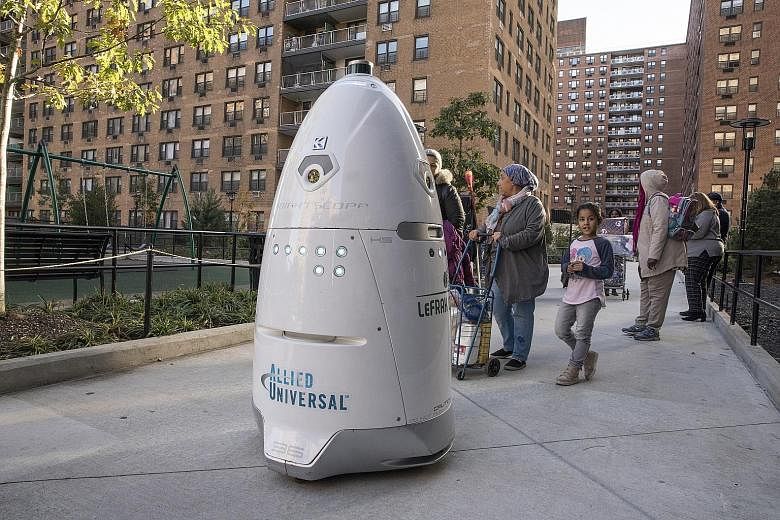NEW YORK • Playing it safe has got a lot easier. Home security has come a long way from the days when hard-wired alarm systems were the only option for single family homes or, in the case of condominiums, a guard or two to patrol the grounds.
Today, wireless or cellular all-in-one systems allow you to check on your house from afar and voice command capabilities let you tell a virtual assistant to shut the garage door while you cook dinner.
As for apartment dwellers, roving robots and camera systems have boosted security and given them more control by shifting video intercom access to cellphones.
In condominiums, property management firms have increasingly installed camera systems with 360-degree vision that can provide data analytics, said Mr Dino Iuliano, chief revenue officer at Planned Cos, a concierge, security, maintenance and janitorial services firm.
These systems send video footage to electronic encoders at security monitoring centres - either in apartment buildings or off-site locations.
The encoders analyse and break down the video into data and send alerts when something is deemed "out of the norm", Mr Iuliano said.
For example, a motion detector that has been triggered can turn on the lights. A package left unattended in an area where it should not be will signal the security firm to alert building staff.
"We're at the point where security in some high-end buildings is starting to resemble systems in casinos and airports," he added.
LeFrak City, a housing complex in Queens, New York, has Rosie, a robot that ambles through the grounds and acts as an "extra set of eyes" for the security team, said Mr Randi Koch Nir, director of lease enforcement at Mid City Security.
The robot, built by Knightscope in Mountain View, California, was rented about a year ago as part of a US$70 million (S$96 million) upgrade to the complex.
Rosie has cameras facing four separate directions, providing a 360-degree view, and patrols the area 24/7. The footage is monitored by LeFrak security personnel.
According to a Knightscope spokesman, Rosie's basic cost structure starts at US$7 an hour.
For apartment buildings that need an intercom upgrade, firms such as Doorport and ButterflyMX have been marketing smart access systems that are operated by cellphones.
These systems require new hardware at the building's front door, but no new hardware or wiring inside individual apartments.
Instead, tenants can use their phones as video intercoms to let guests and deliverymen into the building.
Mr Ben Taylor, chief executive of Doorport, said he is also testing a new product that would allow landlords to upgrade their existing intercom systems without changing the current infrastructure by the front door.
For single-family homes, the technology is not that different and home owners can opt to have a system professionally installed or go the DIY route.
Sensors that detect things such as water leaks or whether a window or a door has been opened can be purchased from hardware stores for as little as US$10 to US$40.
Basic camera systems from companies such as Nest Labs start at about US$200 and get more expensive as more hardware and capabilities are added to the kit.
SimpliSafe offers a DIY kit that includes monitoring services.
Firms such as Nortek Security & Control, which sells products under the 2GIG and Elan brands, among others, also offer add-on products like stove and gun monitors, which are connected to the same monitoring system as the video cameras and intrusion sensors.
If the stove is left on for too long, or if a gun is moved from a locked location, a notification is sent to your mobile phone or a security panel.
Home owners who want a more sophisticated system - say, with cameras that have artificial intelligence or facial-recognition capabilities - may need a professionally installed system with monthly monitoring fees, which can cost significantly more than a DIY kit.
But, then, peace of mind can be priceless.
NYTIMES

